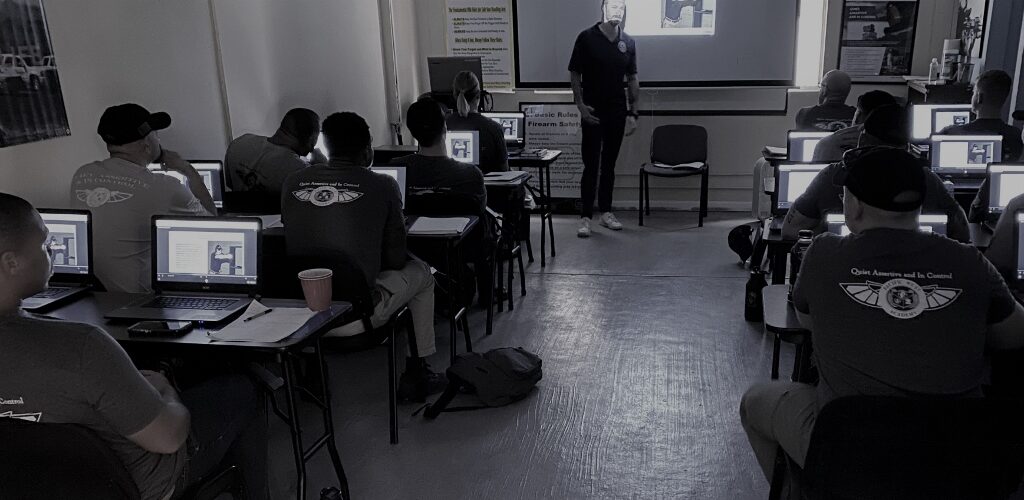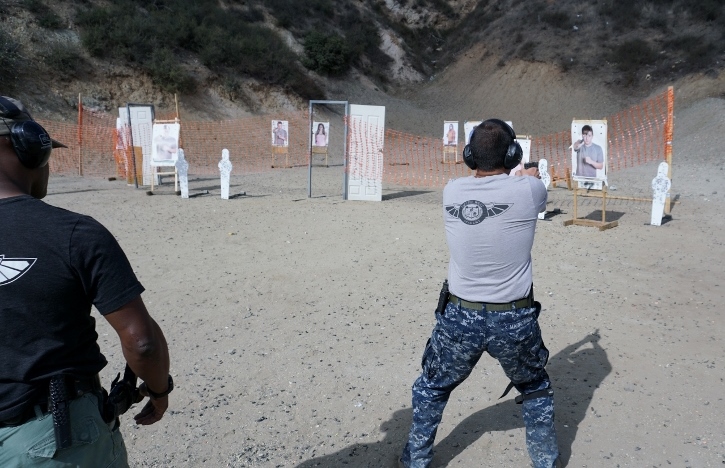

Handgun Shooting Tactics
Handgun Shooting Tactics Course at Pacific West Academy
Many people outside of armed security and law enforcement rarely understand the implications of firing a weapon. They believe it’s just point-and-shoot, and this is something that has been wrongly “taught” to the general public because of film and video games. For anyone that has shot a gun before, they’ll know that it’s not as simple as just pointing your handgun at a target and pulling the trigger. Without the right training, you’ll never hit your target and you’ll just end up shooting a stray bullet or missing a crucial shot that could save many lives.
However, being proficient with a firearm requires you to use it on a regular basis. This is to both perfect your technique and also ensure that you’re physically prepared to fire a handgun. If you’re a retired veteran looking for other ways to utilize your skills, or a security trainee that is building experience, then you may be familiar with the effects that a lack of practice can have on you.
As part of our Handgun Shooting Tactics course, Pacific West goes through firearms handling and will teach you how to handle your pistol in addition to many other training courses. In this article, we’re going to go through a couple of the most important handgun shooting tactics that all trained personnel and security services use in order to protect innocent lives and strike down dangerous people.
Perfecting Your Stance
While some people might find the concept of a stance to be useless especially when you’re in the heat of the moment, the way you position your feet and hold your arms out are the foundation of shooting your handgun. If your legs are shaking or your arms aren’t comfortable locked, then you’re going to miss your shot and your bullet could stray and strike a civilian.
All security personnel and armed security understand the importance of maintaining a solid stance whenever they shoot. It’s to prevent loud sounds, explosions and returning gunfire from shaking you and causing you to lose focus. The main priority is to be as comfortable as possible when you shoot. You should be leaning forward slightly to manage the recoil of your gun. The distance you lean will depend on how much recoil you expect from the gun.
Gripping Your Handgun
The grip of your pistol is also another important factor that will be taught in great detail during our security training courses. You need to grip the pistol firmly enough so that it doesn’t move in your hands, but you need to loosen up if your hand starts to ache or tremor. The goal is to reduce any movement from the fingers that are not placed on your trigger. This is so you have more control over your shot and less interference. If you fire a shot and your hand is moving too much, then you’re not gripping tightly enough.
Your fingers also need to be able to reach the controls of the gun. Whether it’s the safety or the magazine release, make sure you focus on being able to reach all of the controls when you grip your pistol. If you have small hands then you may need to adjust your grip slightly to ensure you can reach these important handgun components. The type of gun will also play a factor here, which is why many armed security professionals like to choose their own handgun that fits the size of their hand, enables them to grip the gun firmly and also allows full access to the controls.
When pulling the trigger, make sure that your forearm is in a straight line to the gun. This is so that the recoil is absorbed by the entire arm and not just the thumb. If your grip is too wide, then your gun won’t be aligned with your forearm and you won’t have control over your firearm. Not only this, but it will become painful to shoot if only a small part of your hand is able to absorb the shock of each shot.
Pulling the Trigger
Discharging the firearm is a simple concept. You pull the trigger with your sights on the target and you hit them. However, pulling the trigger is often overlooked, even for experienced shooters. The basic flow should go something like this; you hold the gun with your firm grip, align your sights, place your finger on the trigger, press the trigger towards you while keeping the rest of your body static, then the firearm will be discharged.
When done correctly, only your trigger finger should move and the rest of your body will absorb the impact. If you find your hand jerking when you shoot, then your shot will be off target and in the field, this could end up striking an innocent civilian. Many inexperienced shooters will instinctively move their arms, fingers or hand to brace for the impact, much like how shooting a pistol is depicted in the movies. However, in reality, moving anything but the trigger finger is bad technique.
It’s important to squeeze the trigger firmly but slowly. Rushing this process will only make your shot inaccurate and you’ll struggle to hit your target.
At Pacific West, we strive to provide the most comprehensive security training course that you can find. Whether you’re training to become school security, hotel security, personal protection or even learn more about threat assessment, we have a Comprehensive Security Training (CST) course that lasts 104 hours and will teach you everything from firearms handling to chemical agents.
